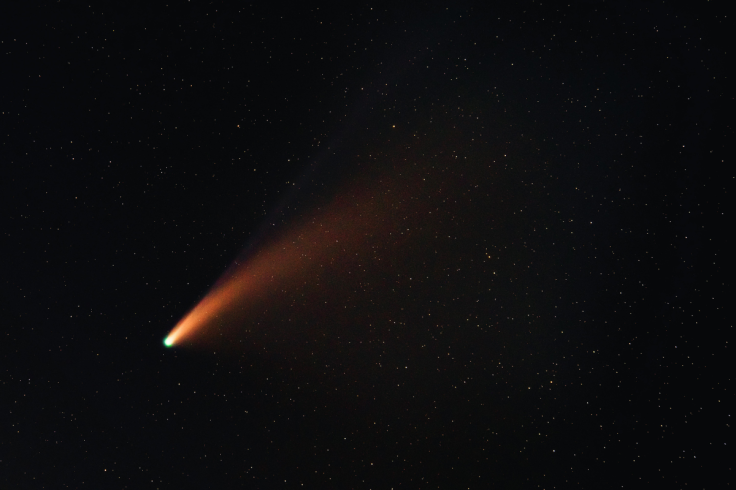Is NASA's 3i Atlas Comet Headed Towards Earth? Conspiracy Theories And The Truth According To Scientists
Weighing over 33 billion tonnes, it emits a teardrop-shaped dust cocoon, offering rare insights into distant cosmic origins.

Social media erupted with panic as whispers of NASA's 3I/Atlas comet barrelling towards Earth fuel alien invasion theories and doomsday predictions. This interstellar object, hurtling at blistering speeds through our solar system, has sparked debates from viral X posts to expert rebuttals, blending cosmic awe with unfounded fears.
Scientists urge calm, confirming no collision risk, yet online hysteria persists amid 2025's celestial curiosities.
Discovery of the 3I/Atlas Interstellar Visitor
Astronomers first spotted the 3I/Atlas comet on 1 July 2025, via NASA's ATLAS telescope in Chile, marking it as the third confirmed interstellar object to pass through our solar system. Travelling at 210,000 kilometres per hour, this icy wanderer may have a nucleus up to 5.6 kilometres wide, though Hubble observations suggest it could be as small as 320 metres across.
Weighing over 33 billion tonnes, it emits a teardrop-shaped dust cocoon, offering rare insights into distant cosmic origins. Its path brings perihelion on 30 October 2025, skimming 210 million kilometres from the Sun, inside Mars' orbit, where NASA's SPHEREx mission captured tantalising data on its enigmatic glow. Mars orbiters from NASA, ESA and China are preparing flyby views, highlighting international collaboration.
No unusual behaviour has been noted beyond expected cometary activity, yet its speed and composition intrigue experts like Harvard's Avi Loeb, who speculates on exotic possibilities without endorsing extraterrestrial claims. This visitor, dubbed C/2025 A3 (ATLAS), will exit our system post-flyby, a fleeting spectacle for stargazers.
Conspiracy Theories Fuel Online Frenzy
Rumours ignited on 29 September 2025, with viral claims portraying 3I/Atlas as an alien mothership or engineered probe, citing its lack of a typical cometary tail and fine-tuned trajectory as evidence of artificial design. Social media exploded with theories of reconnaissance missions, linking NASA's temporary data hold during the Mars flyby to alleged government cover-ups. Speculation snowballed on social media: @NYCryptoKing's remote viewing post envisioned microbial drops and signals, while @maniaUFO listed 'anomalies' like negative polarisation and odd ratios as proof of artificial origin.
Just remote viewed interstellar comet 3I/ATLAS. It's pulling energy from everywhere around it, glowing intensely bright as it accelerates. This thing is ancient—tech only advanced aliens could build. Onboard: tiny microbial life, it's plans to drop on Earth during its solar… pic.twitter.com/kK572AN6OH
— ▪️ J.P ▪️ (@NYCryptoKing) October 6, 2025
Anomalies Stacking Up: 3I/ATLAS Assessment...🧐🤔☄️☄️☄️☄️☄️☄️☄️☄️☄️
— UFO mania (@maniaUFO) September 26, 2025
3I/ATLAS is not behaving as a natural comet. Observational data from multiple instruments present anomalies that cannot be reconciled within standard cometary models. Attempts to explain the data with known… pic.twitter.com/WxpSBHowZH
Some tied it to biblical prophecies and secret military ops, portraying the object as a harbinger of invasion or microbial threats. These narratives prey on the comet's interstellar mystery, blending pseudoscience with genuine awe.
Will this be the ‘signs from the sky to fool even the elect of that were possible’ that #Jesus warned us of?
— CC Angels Sing (@Ccangelsing) October 2, 2025
Or something else?
3I/ATLAS Triggered a Military Emergency Meeting — Experts Say the Threat... https://t.co/ULFOmCPv5P via @YouTube
Al Jazeera's SANAD fact-check exposed fabrications, noting no evidence of reconnaissance missions or biblical ties such as an October 22 tail impact. These theories thrive on misinformation, exploiting cosmic unknowns.
Scientists Reassure: No Earth Collision Risk
NASA confirms 3I/Atlas poses zero threat, with its closest Earth approach a safe 270 million kilometres on 21 July 2025—over 1.7 times the Earth-Sun distance. ESA echoes this, calculating perihelion as too distant for planetary harm, with the comet fading from view after 30 October.
Experts from Northeastern University affirm its cometary nature, dismissing alien probes via spectral analysis showing icy dust, not technology. 'We're not really sure where it's going to end up until it comes around from the other side of the sun, and starts heading out to the outer solar system again,' notes a NASA statement, emphasising scientific monitoring over panic.
As 6 October 2025 unfolds, telescopes around the world track 3I/Atlas during its close pass by Mars, gathering data on its formation beyond our solar system. Media outlets have debunked alarmist claims, clarifying that NASA's SPHEREx findings point to compositional curiosities, not signs of alien technology. People need not fear; instead, they should embrace this interstellar visitor as a rare gift to learn more about the universe.
© Copyright IBTimes 2025. All rights reserved.




















